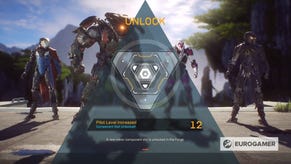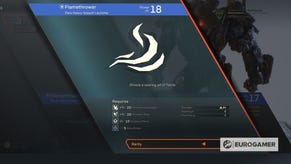Anthem review - shaken apart by its own identity crisis
God save it.
We've been here before. In 2012, BioWare released Star Wars: The Old Republic, an online role-playing game modelled closely on World of Warcraft. At the time it was the most expensive video game ever made: a mammoth, high-stakes undertaking in a genre BioWare, which specialises in epic storytelling for a solo player, had no experience of and didn't seem entirely comfortable with. Its fully voiced dialogue and multiple branching storylines clashed awkwardly with the streamlined social play of an online world.
Seven years later, it feels like BioWare's publisher EA has once again directed it into hostile territory with a huge war chest but no map. This time, Destiny is the target, a "loot shooter" that hooked millions of players by bringing the infinite grind and social dynamics of WOW to the first-person shooter. Once again, the genre doesn't seem to play to BioWare's strengths. And once again the studio's answer, Anthem, has snowballed into a colossal, eye-wateringly expensive project that consumed all of BioWare's development teams as it rolled towards last week's release.
The outcome is different, though. The Old Republic was copybook stuff, a studious and polished imitation of Blizzard's game that did little interesting and got little wrong. Anthem takes more risks, is more original - and makes more mistakes. Much more. It seems not just unfinished but only half-started, a game caught in the act of figuring out what it is supposed to be.
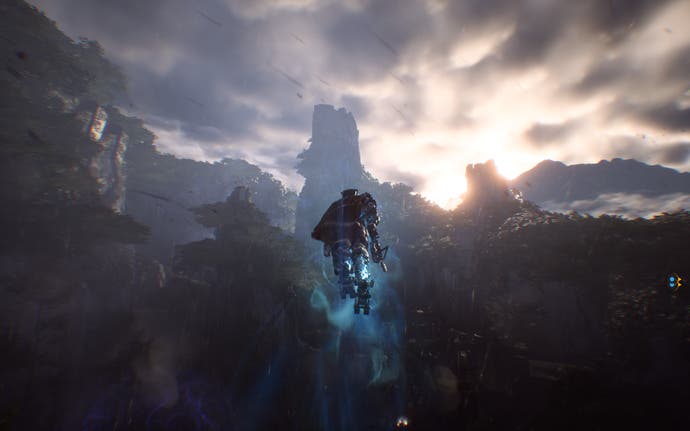
At first, it seems clear that it is supposed to be Destiny. It's there in the name, chosen for its sonorous emptiness and vaguely aspirational quality. It's there in the artwork, which likes to contrast rust and ruin with lush futurism, comic-book cool and medieval pomp. It's there in the setting and storyline, which favour ancient powers, vague existential threats and a strain of sentimental melancholy for a lost golden age. And it's there in the game's architecture, which bolts action-game mission design into the superstructure of a massively multiplayer role-player: loot, levelling, repeatable activities, reputation grinds and tough co-op 'dungeons' for small teams of players.
Moment to moment, though, Anthem is a very different game. Destiny is above all else a first-person shooter, and a refined one at that, built on the classic action loop of developer Bungie's own Halo. It is all about guns, which take centre stage in the action, in the metagame and in the mythos as you hunt or grind for outlandish weapons with exotic names and powerful abilities.
Anthem - and you would be forgiven for not realising this, as the game itself does not appear to fully understand it - is not really about guns at all. They're there, you can shoot them and collect them, but they are not the stars of the show. These are the Javelins, the four mech suits you collect over the course of the game, in the order of your choosing, which serve as Anthem's character classes. They're all capable of rocket-propelled flight, and they all have unique abilities - two 'gear' slots, a melee attack, an ultimate and a combo effect - that are far more effective and more important to the combat than the guns.
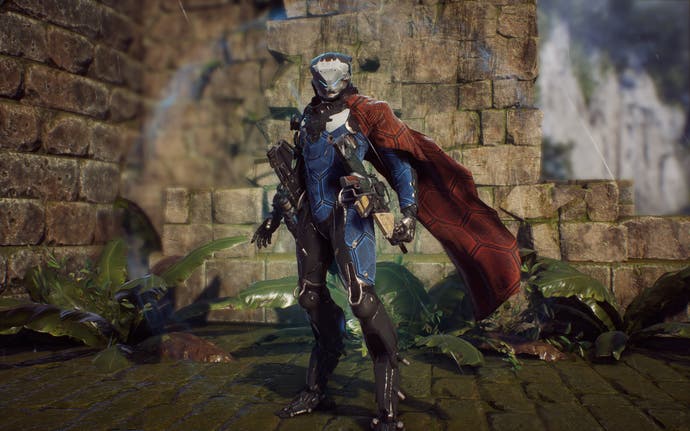
This isn't a shooter at all. It's a third-person mech action RPG that owes as much to Diablo as it does to Destiny. The four suits play markedly differently and have very strong flavours. The Ranger is an Iron Man-inspired mobile weapons platform and jack of all trades, with a lot of rocket-based attacks. The Interceptor is a sort of robot ninja, an agile suit with strong melee attacks that darts in and out of the action. The Storm is a space wizard, a glass cannon archetype that hovers above the field of play and unleashes powerful elemental attacks. And the lumbering Colossus is a heavy tank that can soak up damage and deal with large crowds with mortars and heavy artillery.
These are wonderful creations. The flight controls are beautifully done, weighty yet nimble, with a fun cooling system that has you diving, skimming the surface of lakes or zooming through waterfalls to cool your suit and extend flight time. Flying through the world of Bastion, which is largely composed of deep canyons linked by tunnels, ravines and rock arches, is a game and a pleasure in itself. The way your Javelin rockets off with a click of the left stick, or slams down into the ground with another, gives you a satisfying physical connection to the world.
I spent the most time with the Storm and the Colossus suits. The Colossus is a glorious brute that stays grounded and in the thick of it, shield-slamming into enemies to pick up health drops and keep its defences topped up. The Storm is fragile but gets a shield bonus when hovering, so you're encouraged to keep to the skies and use a teleport to dodge bigger attacks. Unlike Destiny's samey classes, the play experiences couldn't be more different.
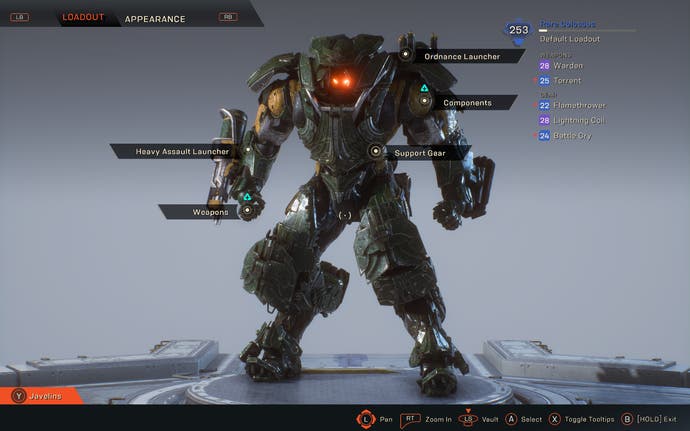
Customisation hinges on your two gear slots which, like a much simplified version of Diablo 3's interchangeable suite of skills, allow great flexibility to specialise your build, angling it towards single target damage, area-of-effect, crowd control, range or melee. Gear skills vary in style and in how active or passive they are, but all operate on some form of cooldown and do much more damage than guns, which are best used to do filler damage when your skills are on cooldown or to compensate for weaknesses in your build (adding a sniper rifle to allow a close-range Colossus build to deal with distant enemies, for example). They also interact with each other via a combo system that is vital to maximising your damage but barely explained within the game. For example, one particularly good close-range Colossus build involves using a flamethrower to 'prime' waves of enemies and a shock coil to 'detonate' them with automatic lightning strikes, triggering the Colossus' combo effect - which causes them to explode on death and deal yet more area-of-effect damage in a deliciously violent, self-sustaining cascade.
It's enormously satisfying to tinker with gear skills and hone your build - or builds, since the game allows you to save multiple setups and doesn't require you to level the Javelins separately (though, naturally, those you spend the most time with will have the best equipment). Once you master gear skills and find a build that suits you, you will forget the rather weedy gunplay and unearth the fun in Anthem's scrappy but enjoyable and distinctive combat.
But once you delve deeper still, things start to fall apart. There is so much hesitancy and half-formed thought in this game's systems. Support skills - party buffs, shields and so on - appear to be a late and consequently lame addition. Support play isn't taken seriously at all; there are no healing abilities to speak of, which limits the possibilities for real teamplay and class synergy. Gear skills are treated as loot, which means that your ability to experiment is dependent on drops, or that you sometimes have to choose between optimising your character and keeping a favoured playstyle - not a fun choice. Experimentation with your build, which ought to be one of the most fun and liberating aspects of the game, is severely discouraged by the fact that your suit's loadout can only be changed in the hub word of Fort Tarsis and never out on the field of play.
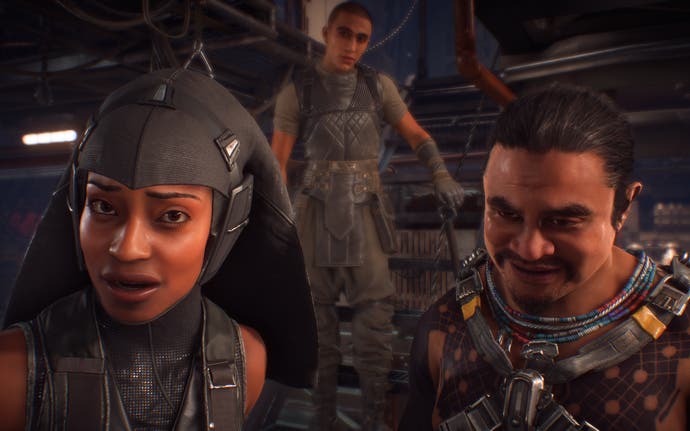
Worse still for the game's long-term prospects, all this plugs into an insipid item game. Loot in Anthem just isn't fun or desirable. Most drops represent minor improvements on something you already have and, as you move towards endgame, you are swiftly overwhelmed with fiddly min-maxing as you try to match the affixes on your equipment to the strengths of your build, optimising by a percentage point here or there. Eventually, you are steered hard into farming for crafting materials and endlessly rolling and rerolling craftable items to get those affixes just right. It's a pure, incremental numbers game, with none of the sense of adventure of heading out to quest or grind for legendary rewards, nor the lottery-winning thrill of finding an ultra-rare drop.
Diablo 3 launched with a terrible item game that suffered some of the same problems; by the time of its first expansion a couple of years later, it was a joyous fiesta of loot. So maybe this can be fixed. But it's fair to say that Diablo 3's fundamentals were far more sound than Anthem's, and that there is much else about BioWare's game that needs fixing.
The user interface is inordinately cumbersome, illogical and slow, which is never a good thing but which is a cardinal sin in a social game that, it is hoped, players will live with for hundreds of hours. It desperately needs a total, ground-up rework. Many of the game's systems are poorly explained (if at all), but many more defy explanation; they are poorly conceived, muddy in thinking and execution, fudged in their relationships to each other. It would be easy to play Anthem for weeks without understanding the Alliance system that rewards social play, for example, or without realising that crucial crafting blueprints are unlocked by levelling up your reputation with certain friendly factions, or without spending any Coin at all in the game's totally undeveloped economy. (There's a second, real-money currency that can be spent on cosmetic customisation only.) Anthem's design is full of botches, sketches, quick fixes and threads that lead nowhere.
As you play and think about what on earth happened during Anthem's long but halting development (many at BioWare had to down tools to bail out the similarly troubled Mass Effect: Andromeda), a picture emerges of a directionless production, full of industry and craft, but failing to coalesce at the highest level. Nowhere is this clearer than in the disconnect between the game's two spaces, Fort Tarsis and the wilds of Bastion. Both are beautiful to behold, but they house completely different games.
The first game, familiar to fans of Mass Effect and Dragon Age, takes place in the meticulously realised fishbowl of Fort Tarsis: somewhere to stroll, tinker and indulge in languorous chat with a bustling supporting cast. These characters - performed with warmth by a strong cast - lend humour and humanity to the game's stodgy lore and perfunctory, MacGuffin-chasing plotlines. Fort Tarsis is a strictly single-player space, viewed in first-person, closed and intimate, perhaps a little pedantic in its insistence that you stop rushing about and soak it all in. (BioWare added the ability to sprint there at the eleventh hour - and apparently through gritted teeth, since it is more of a brisk stroll, maybe a trot, than a sprint.)
From Fort Tarsis, you head out - through a convoluted mission launch screen and a long, long load - to Bastion, which is pretty much its opposite: vast, action-packed, shared with other players and teeming with enemy combatants, but somehow empty. It is a lurching gear change, and BioWare doesn't help by stepping in and telling you how to enjoy its creation. Anthem is designed as a co-op game and I respect that the default option is to matchmake you into a team of four players, but if you try to change this - by finding the almost-hidden option to switch to a private session - the game censoriously reminds you, in a pop-up, that this is not how it was intended to be played, and makes the default response to switch back to a public game. Once in game, it keeps nagging you with pop-ups if you fail to keep up with the group.
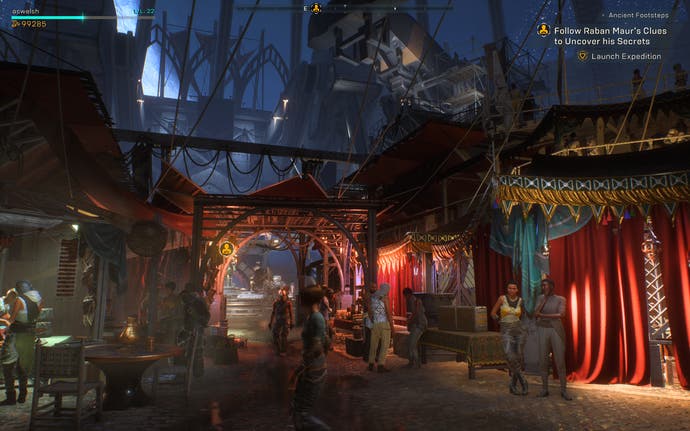
It's true that Anthem is not very enjoyable solo, but nor is it best played with strangers, who tend to rush at objectives and with whom it's hard to communicate. A private game with friends, where you can take your time, talk and explore the sympathetic abilities of the Javelins, can be terrific fun. (If you enjoy PVE and have a reliable squad, this game is a good bet, despite its flaws.) Regardless, it is not the done thing in online worlds to legislate fun, and BioWare should be seeking to empower and embrace different styles of play. Its rigid insistence on segregating your game experiences - co-op action over here, customisation and loot over here, take your action in company and your story alone - speaks of a profound discomfort with this style of game. It's as if the developers didn't believe they could do it all at once.
The shame of it is that many of these component parts have promise and have hooks that work - or that might do with a little more time. It is unavoidable that Anthem is sorely underdeveloped. BioWare has worked fast to patch the many bugs evident in its demo and early access phase, to ensure mostly reliable connection to the servers and to smooth over some of the performance issues - though this is still a game that chugs on most platforms and feels technologically ahead of itself. But there would be much less to worry about if it was just broken.
Anthem is also small. The map is expansive, sure, and presents stunning vistas, but there's not much variety of terrain or mood. Variety is an even bigger problem in the basic, repetitious mission design. Story missions, Strongholds (the game's dungeon or strike equivalent) and Contracts (repeatable missions which come in high-difficulty legendary variants) are near indistinguishable from one another. Boss designs are few in number and terribly overused. There just isn't enough here to sustain the endless endgame Anthem is set up for. Anthem is going to need a constant flow of updates to keep players interested, but it's also going to need major expansions, with meaningful content - meaning new locations, enemy designs and mission types, not just new dialogue - and it's going to need them soon.
Loomed over by the cliffs of Bastion, threading through the warren of Fort Tarsis, chipping away at improvements to your Javelin... More often than not, Anthem makes you feel hemmed in. Claustrophobic. This is the last thing you want to feel when playing in a shared world like this, but here we are, and it feels like the people who made the game are down here with us. For whatever reason, BioWare couldn't climb far enough up this mountain to see what the landscape looked like from the top. It had no clear vision for Anthem, so neither do we. All is not lost; those Javelins make a persuasive case for their own existence, and almost everything else can be fixed or fleshed out in time. Anthem can be saved. But it's going to be a long climb.




